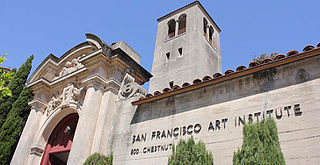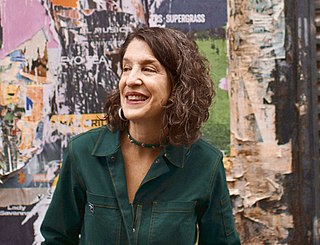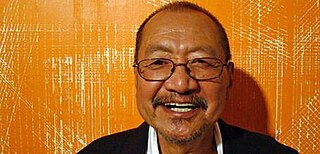
San Francisco Art Institute (SFAI) was a private college of contemporary art in San Francisco, California. Founded in 1871, SFAI was one of the oldest art schools in the United States and the oldest west of the Mississippi River. Approximately 220 undergraduates and 112 graduate students were enrolled in 2021. The institution was accredited by the Western Association of Schools and Colleges (WASC) and the National Association of Schools of Art and Design (NASAD), and was a member of the Association of Independent Colleges of Art and Design (AICAD). The school closed permanently in July 2022.

Bill Daniel is an American experimental documentary film artist, photographer, film editor, and cinematographer. He is also an installation artist, curator, and former zine publisher. His full-length film, Who is Bozo Texino? about the tradition of hobo and railworker boxcar graffiti was completed in 2005 and has screened extensively throughout the United States and Europe. Daniel has collaborated with several artists from the Bay Area Mission School art movement, notably Margaret Kilgallen and has worked on multiple projects with underground director Craig Baldwin. Film/video artist Rankin Renwick of the Oregon Department of Kick Ass has been a frequent touring partner, collaborator and co-curator.

The Chinese Culture Center of San Francisco is a community-based, non-profit organization established in 1965 as the operations center of the Chinese Culture Foundation located in Hilton San Francisco Financial District, at 750 Kearny Street, 3rd Floor, San Francisco, California, United States.

Martin Wong was a Chinese-American painter of the late 20th century. His work has been described as a meticulous blend of social realism and visionary art styles. Wong's paintings often explored multiple ethnic and racial identities, exhibited cross-cultural elements, demonstrated multilingualism, and celebrated his queer sexuality. He exhibited for two decades at notable New York galleries including EXIT ART, Semaphore, and P.P.O.W., among others, before his death in San Francisco from an AIDS-related illness. P.P.O.W. continues to represent his estate.
David Kenneth Ireland was an American sculptor, conceptual artist and Minimalist architect.
Squeak Carnwath is an American contemporary painter and arts educator. She is a professor emerita of art at the University of California, Berkeley. She has a studio in Oakland, California, where she has lived and worked since 1970.

San Francisco Cinematheque is a San Francisco-based film society for artist-made cinema. It was created in 1961 by a group of filmmakers, including Bruce Baillie and Chick Strand. This screening program grew into Canyon Cinema before being split off into a sister organization, originally named the Foundation for Art in Cinema, during the 1970s.

Lynne Sachs is an American experimental filmmaker and poet living in Brooklyn, New York. Her moving image work ranges from documentaries, to essay films, to experimental shorts, to hybrid live performances. Working from a feminist perspective, Sachs weaves together social criticism with personal subjectivity. Her films embrace a radical use of archives, performance and intricate sound work. Between 2013 and 2020, she collaborated with musician and sound artist Stephen Vitiello on five films.
Paul Joseph Kos is an American conceptual artist and educator, he is one of the founders of the Bay Area Conceptual Art movement in California. Kos incorporates video, sound and interactivity into his sculptural installations. Currently Kos lives and works in San Francisco.

Janis Crystal Lipzin, is an American artist and educator, working with film, photography, video, audio, multi-media installations, and media performance. Lipzin is known for her work in many media and taught at the San Francisco Art Institute for over three decades. Lipzin's films offer a unique blend of rigorous conceptual structure, formal investigation, and sensual discovery. The Bladderwort Document is a haunting visual fantasia of her life on a farm in the 1970s; Trepanations is a droll meditation on social forces and women's appearance; and Seasonal Forces, Part One creates a fluid and immediate record of the cultural and seasonal changes in the rural landscape where she lives.She has been an active filmmaker since 1974, when she became attracted to using Super-8 cameras, in part because of their easy portability and flexibility to make changes to a film up to the moment of projection. Her more recent work incorporates both digital and analog film methods. wherein light and photo-chemistry collide and conspire to reveal aspects of our world deserving of more careful scrutiny. Her work blends an enduring interest in the volatility of nature and human events with a sympathy for alternative, hand-made methods that she interweaves with digital processes. Lipzin is based in Sonoma County, California.

Lynn Marie Kirby is an American visual artist, filmmaker and teacher. She lives in San Francisco, and is professor emeritus at the California College of the Arts (CCA).

Carlos Villa was a Filipino-American visual artist, curator and faculty member in the Painting Department at the San Francisco Art Institute. His work often explored the meaning of cultural diversity and sought to expand awareness of multicultural issues in the arts.
Taravat Talepasand is an American contemporary artist, activist, and educator, of Iranian descent. She is known for her interdisciplinary painting practice including drawing, sculpture and installation. As an Iranian-American woman, Talepasand explores the cultural taboos that reflect on gender and political authority. Her approach to representation and figuration reflects the cross-pollination, or lack thereof, in our Western Society. Talepasand previously held the title of the chair of the painting department at San Francisco Art Institute (SFAI). She is an assistant professor in art practice at Portland State University.
Art is a popular form of expression within the Asian American community and can be seen as a way for the community to push against tradition. Common forms of art are painting or photography and the first known record or Asian American art was in 1854, in the form of a photography studio by Ka Chau entitled "Daguerrean Establishment". Performance art became a popular form of expression by the 1960s, allowing artists like Linda Nishio to focus on issues of representation and self-image. Music is also used as a form of expression within the Asian American community.
Tony Labat is a Cuban-born American multimedia artist, installation artist, and professor. He has exhibited internationally, developing a body of work in performance, video, sculpture and installation. Labat's work has dealt with investigations of the body, popular culture, identity, urban relations, politics, and the media.
Rebeca Bollinger is an American artist. She works with sculpture, photography, video, drawing, installation, writing and sound.
Dewey Crumpler, is an American painter and educator. He taught at the San Francisco Art Institute (SFAI) for many years, where he held the title of associate professor.
Xiaoyu Weng (翁笑雨) is a Shanghai-born, New York-based curator, writer, editor and educator in the area of contemporary art.
Vincent Grenier (1948–2023) was a Canadian avant-garde filmmaker.









